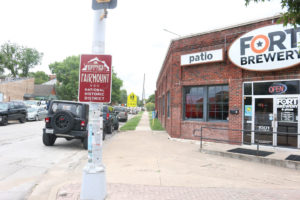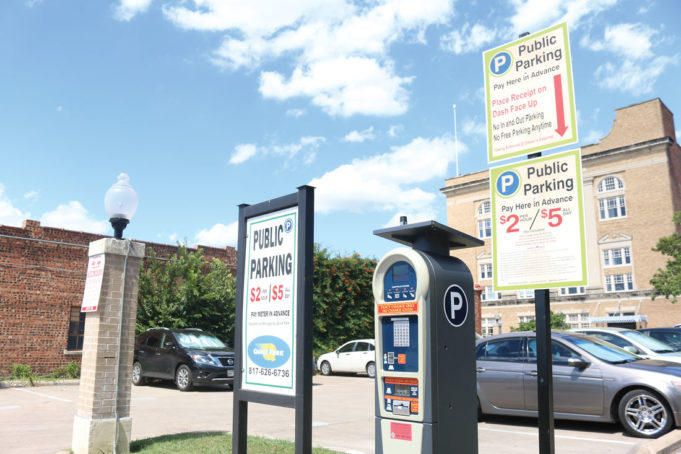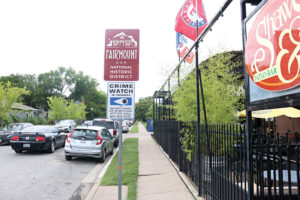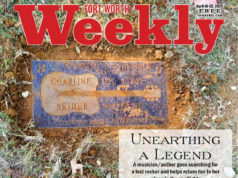I first caught wind of the rumor of paid parking on West Magnolia Avenue on Friday, June 7, toward the end of my shift at the Boiled Owl Tavern. That’s when I overheard my friend and industry colleague Cody Soape talking about the comment string on a Facebook post he had made earlier in the day. I was on the back half of working a double, so somehow I’d missed all the excitement, but his post went like this: “So who exactly is pushing for paid parking on Magnolia? That does not benefit businesses, employees, or residents. Can someone enlighten me?”
The possibility of paid parking on Magnolia was news to me, and like many others who contributed to the discussion (which, at this writing, totals 89 comments), I responded in a reactionary, knee-jerky (and generally jerky) tone. Doing the math in my head, and basing the potential cost of parking at my job on a semi-arbitrary rate of $3 per shift, I figured that, for me, the monthly cost of parking would roughly equal the money I make during a Thursday happy hour. In my monthly budgetary projections, the income from at least one of those happy hour shifts goes toward expenditures like food, gas for my car, or, at least recently, my current obsession with buying houseplants. The notion of coughing up the cost of parking on Magnolia for 12 to 20 shifts a month was exceedingly frustrating for a few reasons. Thanks to the sharp increase in rental rates over the past seven years or so, a person who works in that neighborhood’s service industry can hardly afford to live nearby already and probably has to drive to work. Making employees pay to park scrapes their wallets even further. And then, because paid parking typically involves a time limit, and if you (or, most pertinent to my gripey Facebook commentating, me) work at a place where alcohol sales are a centerpiece of its business model, customers are less likely to park their asses on a barstool for hours upon hours if they have to get up to feed a meter or move their car because they maxed out the time on a parking app. If you (like me) are prone to blowing a gasket over watershed news flashes like this, your imagination (like mine) might have also seethed with images of tow trucks zooming in, jacking cars, and zooming out like a cast of hawks at an unguarded rabbit farm. Also, what about if you have to walk a couple blocks to your car at 3 a.m. after your shift? That sounds sketchy to me, and I’m a dude. For women who work that late? Hell fucking no.
But Facebook freakouts aside, parking on Magnolia, while maybe not a crisis today, is certainly an issue. As nearly every Uber driver who drops you off on that street is wont to remark upon, Magnolia is “really blowin’ up!” A decade ago, the action was largely confined to the blocks and businesses nearest to 8th Avenue – the Chat Room Pub, King Tut, Spiral Diner, Nonna Tata – but that’s changed in the years since. I’m biased, so I attribute a lot of the development that’s spread eastward down the street to the 2012 opening of the Owl and the erstwhile Live Oak Lounge, not to mention the already extant Yucatan Taco Stand and then-open Mamma Mia Italian Grill & Pizza. Saying the ’hood is booming is practically passé at this point (unless you drive an Uber), except that it still seems to be evolving, and a lot of that has to do with the sheer volume of crowds that amble from one end of the street to the other. It’s not West 7th-level congestion yet, but give it some time and a few more places to drink, dine, and shop. Paid parking, like it or not, will be a necessity.
*****
I think what also underpins a lot of the concerns of my fellow Magnolia Avenue worker bees and me is that the pernicious specters of parking meters, tickets, and tow trucks is that the culture of the street, which any of us will passionately pontificate about, will irrevocably change to one that’s, well, even busier, bougier, and Varsity Tavern-ier. But amid the furor fomenting on the ad hoc Soape-spawned online parking symposium, Megan Henderson, the director of events and communications of Near Southside Inc., the pro-development nonprofit, tried to palliate the commentariat’s fears. “Paid parking, amazingly, actually provides more opportunities for visitors to patronize your business,” she wrote. “It forces turnover in those most premium and convenient of spaces and discourages employee cars and long-term visitors who are maybe ‘staying with a relative down the street’ or working at a medical office all day to instead park farther away in free parking without time restrictions. By placing a value on a space, you actually free up that space for the most important people: customers.”
Now admittedly, two sirens in my brain went off when I read that: the one that gets mad when something isn’t specifically tailored to my own unique needs and desires and the one that sounds when, to paraphrase David Spade in Tommy Boy, a ketchup popsicle sale is being pitched to a wearer of white gloves. But after I’d cooled off about the discussion and given it some thought, I realized that a paid parking proposal affected only the spaces on Magnolia proper, and in seven years of bartending at the Boiled Owl, I have maybe parked on the street for a shift twice, because the lots behind the bar and adjacent Yucatan (where I almost always park) are owned by the buildings’ property company. “Me” is OK, in other words.
Moreover, Henderson mentioned that Near Southside Inc. had contracted a consulting firm to study the street’s parking situation and make recommendations. In layman’s terms, this is known as “research,” performed by “experts.” To dismiss their findings out of hand is to plop yourself in the cow pasture populated by falsely assured know-nothings mooing and lowing, “Fake news!” about anything they don’t like or that challenges their fiercely clutched beliefs. If I don’t trust in the data collected by experts, I am no different than your average climate-change denier, or a Flat Earther, or anyone who nods agreeably when the president finishes a sentence with “believe me.” You do you, but I’m gonna do me, and doing me means believing in observable facts, such as physically counting the number of spaces on a street and seeing how many are full during lunch.
Henderson directed me to Mike Brennan, president of Near Southside Inc., and we met at the group’s office at 5 p.m. last Monday. It’s incidental to this story, but I had no trouble finding a spot, but then again, the parking issue, as I came to find out, is really about West Magnolia Avenue proper. Or it mostly is. One of the main drivers of the parking situation is visitor spillover into the adjacent residential streets.

Brennan provided me with a lot of useful background information, in particular what Near Southside Inc. does, as well as how it spends its money and where that money comes from. The shortest answer is that NSI basically oversees a TIF, an acronym I have often heard and read but never understood, sort of nodding vacantly with a clueless, Homer Simpson-esque look on my face. Per Cody Soape’s Facebook Chautauqua, I’d wager that lots of the participants don’t really know what a TIF is, either. If you’re one of them, TIF stands for “Tax Increment Finance,” and it applies to districts within a city where the property values within their boundaries are set as a base for a predetermined length of time. A portion of the revenue scooped from the tax revenue goes to developing that district. In the case of Magnolia, that money pays for things like holiday flags and lights in the trees, and, most relevant to where you leave your car before you go to the bar, the maintenance of the parking garage on Alston Street.
Magnolia is in TIF 4, a.k.a. Southside/Medical District, which covers 1,278 acres within the confines of I-30/Vickery Boulevard to the north, 8th to the west, West Arlington Boulevard on the south, and a few blocks east of I-35 at Kentucky Avenue. I was surprised to learn that it has been in place since the fall of 1997, since the street has really only seen dedicated development over the past eight or nine years.
“This level of development takes a long time,” Brennan said with a chuckle.
He’s a pretty affable guy, and at no point did I get a tone of impending doom, but he did stress that the district’s TIF provisions expire at the end of 2022.
“It’s not a huge problem now, and maybe it won’t be then,” he said. “But we realize that we have to look ahead to after the TIF’s duration is up, and what that means is finding a revenue source for the maintenance and continued improvement of the street.”
*****
In the early 2000s, even through the better part of President Obama’s first term, Magnolia was something of a ghost town. I recall talking to long-time Near Southside resident and neighborhood skateboarding OG John Shea about the street for the story I wrote about the annual block party Open Streets (“Skate Jam,” April 13, 2019), and he said one of the reasons he made his home there after moving back to Texas from California in 2004 was that it was more or less empty, a skater’s paradise of vacant lots and few people to bother him. Chat Room Pub co-owner Jon Carney once told me how, when he bought into the bar 15 years ago or so, the only souls drifting around were vagrants. If a TIF district’s funds are the fire that leads to a developmental boom, the fuse is apparently very long. In the case of the Near Southside, it smoldered for 15 years before exploding.
Boom it went, however, and as Brennan pointed out at an afternoon meeting I attended on Monday at Fixture about East Magnolia’s parking situation, it’s sort of surprising that the neighborhood has made it this long without any meters. At that meeting, he presented to a small group of attendees representing that block’s businesses the same information he showed me a week ago. Per both meetings, I learned there are five issues.
 The first is the spillover into the adjacent streets south of Magnolia. “It’s pretty much a given with the neighborhood and councilmember [Ann] Zadeh that we have to at least make that residential parking permit program an option,” Brennan said. “How it works is to be determined. Typically, there’s a fee residents pay. The city ordinance doesn’t actually set fees, so as of now, I don’t think there is a set fee, but that’s generally how it works. You pay a certain amount for a pass. You renew it every year, but that’s to be determined. And it’s not universal among all of those folks who live within the first two blocks south of Magnolia that that’s what they want, so we’re recommending, based on what the study recommends, that the neighborhood looks at it on a block-by-block basis. Where there is consensus support for the residents who live along there, then that would be the areas where there’s a residential permit program. But does that mean all the time? From what we found, it’s basically around lunchtime and around 7 p.m.”
The first is the spillover into the adjacent streets south of Magnolia. “It’s pretty much a given with the neighborhood and councilmember [Ann] Zadeh that we have to at least make that residential parking permit program an option,” Brennan said. “How it works is to be determined. Typically, there’s a fee residents pay. The city ordinance doesn’t actually set fees, so as of now, I don’t think there is a set fee, but that’s generally how it works. You pay a certain amount for a pass. You renew it every year, but that’s to be determined. And it’s not universal among all of those folks who live within the first two blocks south of Magnolia that that’s what they want, so we’re recommending, based on what the study recommends, that the neighborhood looks at it on a block-by-block basis. Where there is consensus support for the residents who live along there, then that would be the areas where there’s a residential permit program. But does that mean all the time? From what we found, it’s basically around lunchtime and around 7 p.m.”
Secondly, there’s the perception and sometimes reality that it’s difficult to find convenient parking on Magnolia. “The definition of convenience is different for everyone,” Brennan said, “but I think we’re fortunate that the expectations of Magnolia Village, for most people, are not that you’re going to find your ideal spot right next to where you’re going. For a lot of people, walking isn’t that big a deal, but if you have mobility issues, those premium spots are important.”
Those premium spots relate to the third issue. “If you look at the premium spots, which are immediately in front of the businesses on Magnolia, even before we commissioned the study, I basically did a windshield survey, took photos of all the cars parked at 10 in the morning and 4 in the afternoon, and just counted the ones that were there both times, and it was like 20 percent of the total number of cars. For a street like Magnolia, that’s a pretty high percentage, at least for those that have the option of parking behind their business or maybe one of the north-south streets.”
At our meeting at the office, Brennan showed me three different types of meters, which varied in convenience of use. The easiest one to operate, currently in use downtown, is the FW Park app, which eliminates even having to fuss with a meter, though if you don’t have the app on your phone, you can still use cash, coins, or card to purchase a parking sticker for your curbside window. Even without the app, inserting your card and buying a couple hours at a downtown parking spot is pretty easy.
The fourth issue relates to the cost of maintaining the current garage and the proposed garage connected with the hotel planned for the corner of Henderson Street and Magnolia.
“The Magnolia Green garage [on Alston] is the only public garage we have,” Brennan said. “It works great during the day. It’s filled with a lot of people who work in the medical businesses nearby, so customers coming to the Owl or Yucatan … or wherever might have to park on the third level, but after 7 p.m., it’s no problem to find a spot in that. It’s not that it’s never used. There’s just an opportunity to use it more effectively in those evening and weekend hours.
“Then the last issue is related to that,” Brennan continued. “If we want to keep that garage as a public facility, then either [Near Southside Inc.] or the city or us working in cooperation with the city need to establish the rules for parking there. And it might be that you pay a little during the day. Maybe it’s free at night. But if we want to continue to use that as a public asset, we’ve got to find a revenue source to pay for the annual maintenance, which is about $75,000.”
Currently, the TIF district pays for the garage’s maintenance until the TIF’s expiration in 2022. “It’s unlikely that we can go to the city council and say, ‘Hey, will you assume this $75,000 annual maintenance fee?’ They’re gonna say we need a revenue source, so if we already have [metered parking] established before the expiration of the TIF, then it’s more likely that we can retain [the garage] for public use. The other parking garage that’s just in the design phase is linked to the hotel that was approved for Magnolia and Henderson. One-hundred-fifty spaces were approved in that garage for public use. If we are able to work with the developer to make that garage happen, we need to find a revenue source to make sure it’s useable for the public long-term.”
Near Southside Inc. commissioned Austin-based consulting firm HWA Parking to conduct the study and have based their recommendations on its findings.
“We want to make sure there’s a perception and hopefully a reality of convenience for all the residents and the visitors and the workers,” Brennan said, “and recognize that not everyone is going to find that space, so there’s not the expectation that you’re going to find that perfect space right next to the business. But we want to make sure coming to Magnolia is a pleasant and safe experience walking from where you parked to where you’re going. We understand there’s a number of things that have to be coordinated, whether it’s a residential permit program or parking meters or some of these strategies related to the garage. All of these have to work in concert with each other.”
That may prove to be the biggest hurdle. For example, the residential parking permit program requires a neighborhood to survey its residents, and the minimum threshold to acquire resident permit parking only after 4pm is 70 percent of that block face to be supportive of it, which may lend to some contentious neighborhood meetings. There’s also the issue of safety. Recall that a woman working until the wee hours of the morning doesn’t want to walk far to her car in any case, let alone with a wallet full of tips. Brennan posits that a ride service to and from parking areas like the garage may be an option, depending on the revenue accrued from parking meters, and he stresses that any monies obtained above the cost of maintaining the parking areas will ultimately go to public improvements.
“We don’t want this to just be driven by revenue,” he said. “Basically, you’re trying to cover the bill for the city. However, if you’re able to cover that bill and make some extra money on top of that, then that can go back to improving the street. Let’s say you pay a small fee to use the Magnolia Green garage and it’s validated by a doctor’s office or a business, and those fees pay for the maintenance on the garage. Then maybe the meters, for which the only real cost you’re paying for is enforcement, make more money than the up-front maintenance cost.
“If that happens, we can establish a parking benefit district, and any surplus revenue stays within that defined area and can pay for more public improvements, [which] are currently being funded by the TIF.
“Things like the lights in the trees, the maintenance crew that waters the trees and replants them when people hit them or they die,” I said. “Or a safe ride from your job to your car at 3 in the morning.”
“Yeah,” Brennan said. “For some of those things, we get some money allocated from the TIF on an annual basis that allows us to do miscellaneous projects within the public right-of-way. In Boulder, [Colorado], they have a whole marketing campaign that’s basically ‘your parking dollars at work.’
“If there’s any pain in the form of people having to pay, we want there to be a discernible benefit beyond the cars turning over more frequently than they used to and I also think it’s important if we want Magnolia to continue to be a special kind of street. We don’t have a lot of streets on the South Side that require that higher level of upkeep, but the ones we do –– Magnolia, South Main –– we want to keep them in the same condition that they’ve been in recently.”
*****
After talking with Brennan, I now see it like this: Paying to park on Magnolia is actually conducive to maintaining the street’s culture and vitality rather than what many fear will “West 7th-ify” the strip. And in all fairness, I found that most employees on the street don’t park in those premium spots anyway. I asked Fixture chef/owner Ben Merritt if his employees parked in front of or on the side of the restaurant, and he said they don’t.
“They know that the more parking that’s available, the better the traffic will be through the door, and everyone will make more money,” he said. And Brennan also voiced another goal for a paid parking scheme: ‘The best outcome for it is if we can reduce the number of visitors arriving in their own cars.’ ”
As a bartender, I can assure that that is indeed the dream. If I knew every customer of mine came and went in an Uber or Lyft or walked to and from the bar, I’d breathe a little easier, and definitely sell a lot more, and, in turn, make more money, thereby making what is really a minor inconvenience – paying to park – not that big a deal.
Editor’s note: The dek has been updated to more accurately reflect the information as it stands now.














Things Fort Worth is finally having to deal with: parking has a cost, free parking is actively harmful to making a better central city, and real cities can’t just hand everything to car users on a silver platter if they want to survive. Amazing.
Residents should not have to pay for a parking permit program in order to park in front of their own house.
I agree with Rich, residents shouldn’t have to pay for a permit especially in an older area where garages are non-existent.